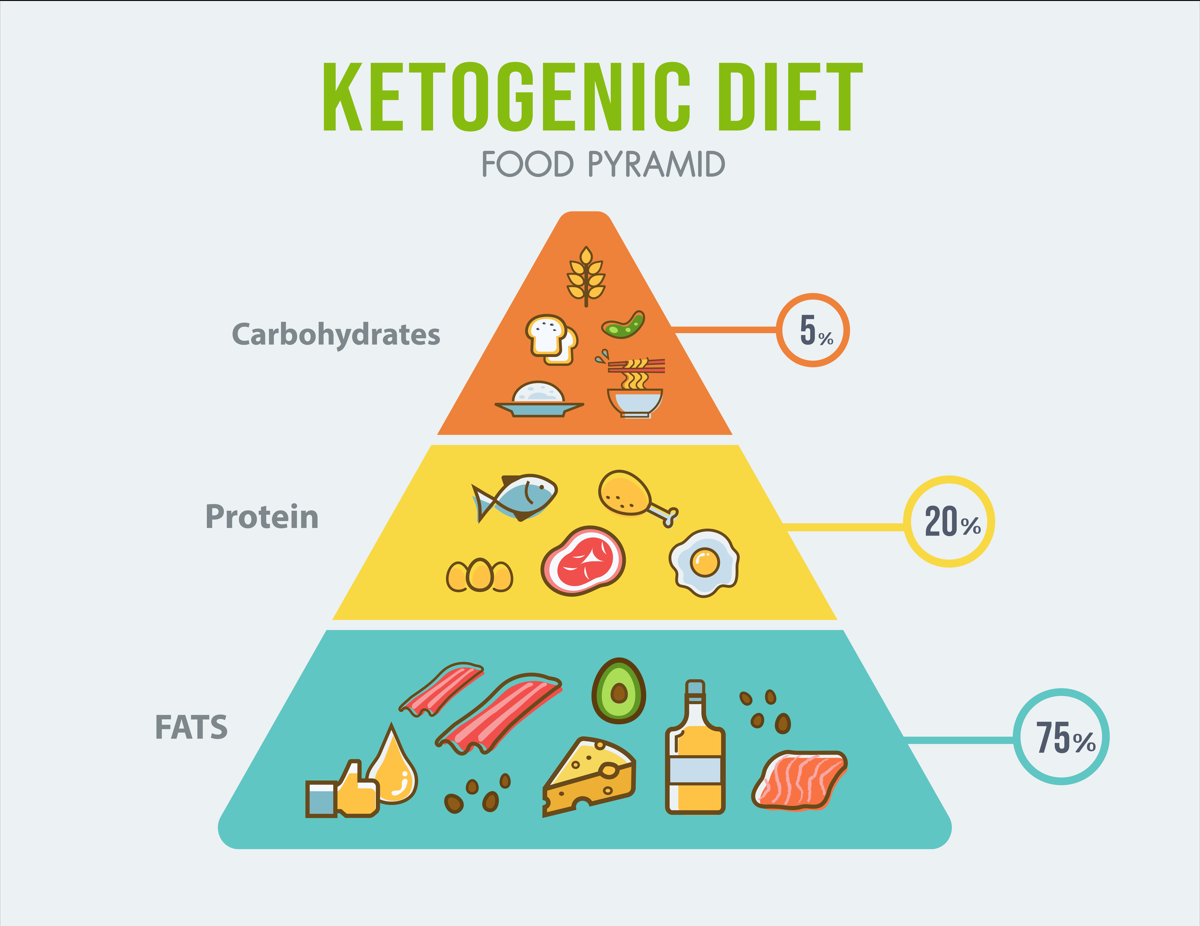

More on Keto & Low Glycemic Index Diets

By Sarah Garone
In the last several years, the keto diet has taken the world by storm. Featured on magazine covers, endorsed by celebrities, and praised on social media, keto has skyrocketed in popularity to become one of the trendiest eating plans in recent memory. Beyond its VIP status in popular culture, the keto diet has also been studied for its potential health benefits—with a particular focus on its effects on diabetes.
The low-glycemic diet, on the other hand, doesn’t necessarily get as much good press, but that doesn’t mean it doesn’t come with benefits of its own. Research shows that this way of eating could also manage diabetes, as well as potentially aid in weight loss and promote heart health.
Wondering if the keto or low-glycemic diet might be right for you? Here’s a look at how the two compare.
What Is the Keto Diet?
When people first hear what the keto diet entails, there’s often a moment of “wait, what?” That’s because, on the surface, keto sounds rather counterintuitive. The basic premise of keto is to consume the vast majority of your daily calories from fat. (After decades of hearing that fat is the enemy, it can be tough to believe this is really a “diet.”) But it’s true: a keto diet typically involves eating about 70% of your calories from fat, 25% from protein, and only 5% from carbohydrates.
Here’s how it works: Normally, the body prefers to use carbohydrates for fuel. But when you take away almost all carbohydrates, you force the body to shift gears into a different metabolic state called ketosis. In ketosis, the liver breaks down stored fats to use for energy, leading to weight loss. The time it takes to achieve ketosis can vary from person to person, but the process usually takes only a few days.
On a keto diet, you won’t eat many grains, fruits, or starchy vegetables. Instead, your meals will mostly consist of high-fat, moderate-protein foods like meats, fatty fish, full-fat dairy products, and nuts and nut butters. A few non-starchy veggies and low-carb fruits can be added to fulfill your small allotment of carbs.
How Keto May Benefit People with Diabetes
Keto was first developed as a dietary treatment for epilepsy, but these days is more often used for weight loss and diabetes management. In fact, there’s a growing body of research that suggests keto may be an effective dietary strategy for diabetes. Multiple studies have confirmed that adopting a high-fat, low-carb diet is effective for both weight loss and better blood sugar regulation. A large systematic review from 2020 that looked at 12 studies found that people on a keto diet decreased their blood sugar, triglycerides, total cholesterol. They also lost a significant amount of weight!
Even people with type 1 diabetes might benefit from going keto. A small 2018 study showed that following a keto diet led to excellent blood sugar levels in people with this form of the disease.
It’s important to note, though, that because a keto diet includes so much fat—much of which may be saturated—experts have concerns about people following it for years on end. Since a high-saturated fat diet is associated with higher risk of heart disease and stroke, keto might not be a long-term solution for many people.
What is a Low-Glycemic Index Diet?
Whereas a keto diet centers around balancing the three macronutrients (fat, protein, and carbs), a low-glycemic index diet focuses solely on carbohydrates. The glycemic index is a ranking system of 0 to 100 that gives foods a score based on how much they raise blood sugar (depending on the types of carbohydrates they contain). Foods are broken down into categories of low (a score of 55 or lower), medium (56-69), and high (70 or more).
The idea behind a low-glycemic index diet is, of course, to keep your blood sugar low by eating mostly low-GI foods. To follow this eating plan, you’ll need to get familiar with common foods’ GI scores to plan meals that won’t send your sugars into overdrive. (Some people like to use an online tool, especially when first starting out.) Foods high in refined carbohydrates, like desserts, white bread, and white rice score high and are limited, but lower-GI foods like whole grains, beans, and non-starchy vegetables are all fair game. Zero-carb foods, such as meats, fish, and oils, aren’t given a GI score and may be included at your discretion.
A low-glycemic index diet doesn’t come with any health risks, per se, but it may be difficult to memorize which foods are low, medium, and high. It also doesn’t present a comprehensive picture of various foods’ healthfulness, since it focuses only on how much they raise blood sugar.
How a Low-Glycemic Index Diet May Benefit People with Diabetes
Like keto, a low-glycemic index diet is a top contender for helping manage diabetes. According to a large systematic review from 2018, people who followed this diet showed significant improvement in their HbA1c—a test that measures blood sugar control over three months. Another review from 2019 revealed that this diet was useful for both steadying blood sugar and promoting weight loss in people with prediabetes and diabetes.
Not only does low-GI eating appear to keep blood sugar steady, it might also help prevent the onset of type 2 diabetes altogether. One study of over 200,000 people showed that those who ate a high-glycemic diet were 33% more likely to develop type 2 diabetes than those who regularly ate low-GI foods.
Last Word
Even with a diagnosis of diabetes or prediabetes, it’s comforting to know that you can be a part of your own treatment program by changing your diet. There’s compelling evidence that both the keto and low-glycemic diets can help bring down blood sugar and bolster weight loss. If you’re looking for foods compatible with these diets, the Un-Possible Kitchen’s variety of low glycemic- and keto-friendly products are a great place to start. (And, for more information about ingredients used on these diet, check out our Common Ingredients page.)
Article Resources:
- American Heart Association. Saturated Fat. 2021.
- Bhupathiraju SN, Tobias DK, Malik VS, et al. Glycemic index, glycemic load, and risk of type 2 diabetes: results from 3 large US cohorts and an updated meta-analysis. Am J Clin Nutr. 2014;100(1):218-232. doi:10.3945/ajcn.113.079533
- Bolla AM, Caretto A, Laurenzi A, Scavini M, Piemonti L. Low-Carb and Ketogenic Diets in Type 1 and Type 2 Diabetes. Nutrients. 2019;11(5):962. Published 2019 Apr 26. doi:10.3390/nu11050962
- Leow ZZX, Guelfi KJ, Davis EA, Jones TW, Fournier PA. The glycaemic benefits of a very-low-carbohydrate ketogenic diet in adults with Type 1 diabetes mellitus may be opposed by increased hypoglycaemia risk and dyslipidaemia. Diabet Med. 2018 May 8. doi: 10.1111/dme.13663.
- Ojo O, Ojo OO, Adebowale F, Wang XH. The Effect of Dietary Glycaemic Index on Glycaemia in Patients with Type 2 Diabetes: A Systematic Review and Meta-Analysis of Randomized Controlled Trials. Nutrients. 2018;10(3):373. Published 2018 Mar 19. doi:10.3390/nu10030373
- Yancy WS Jr, Foy M, Chalecki AM, Vernon MC, Westman EC. A low-carbohydrate, ketogenic diet to treat type 2 diabetes. Nutr Metab (Lond). 2005;2:34. Published 2005 Dec 1. doi:10.1186/1743-7075-2-34
- Yuan, X., Wang, J., Yang, S. et al.Effect of the ketogenic diet on glycemic control, insulin resistance, and lipid metabolism in patients with T2DM: a systematic review and meta-analysis. Diabetes 10, 38 (2020). https://doi.org/10.1038/s41387-020-00142-z
- Zafar MI, Mills KE, Zheng J, Regmi A, Hu SQ, Gou L, Chen LL. Low-glycemic index diets as an intervention for diabetes: a systematic review and meta-analysis. Am J Clin Nutr. 2019 Oct 1;110(4):891-902. doi: 10.1093/ajcn/nqz149.
Sarah Garone, NDTR, is a nutritionist, freelance health and wellness writer, and food blogger.
She began her career as a college German instructor, but after taking a break to raise her three children, became fascinated with food and nutrition. She returned to school to earn a degree in nutrition and became a nutritionist licensed with the Academy of Nutrition and Dietetics. Along the way, she started her food and nutrition blog, A Love Letter to Food, where she shares (mostly!) healthy recipes and nutrition information.
As a freelance writer, Sarah writes for a variety of publications on health, wellness, lifestyle, parenting, and Catholic spirituality. She has contributed to outlets such as Healthline, Greatist, Verywell, Brit + Co, Today’s Parent, and the Washington Post. When she’s not writing (or cooking), she teaches a monthly kids’ cooking class called Toddler Test Kitchen.



